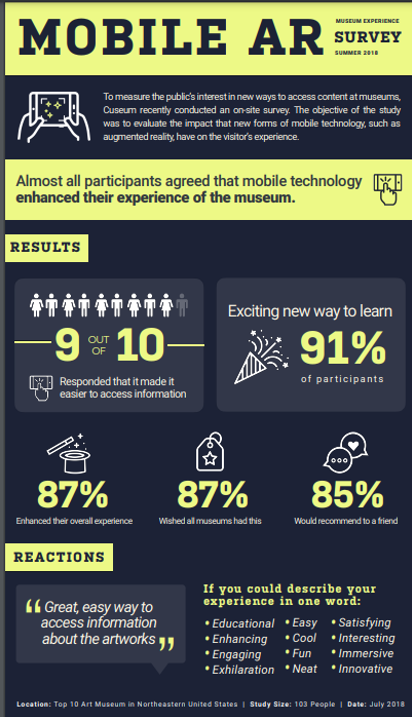
At Cuseum, we’re deeply interested in how new technology and approaches impact the multitude of ways museums and cultural attractions interact and engage with their visitors. Over the past few years, we’ve watched many changes redefine how organizations think about digital engagement and the general expectations and behaviors of their visitors.
Consumer expectations are evolving and rising faster than ever before. As consumers experience new things on their smartphones that are faster, more fun, and more personalized, the bar for expectation and experience is pushed higher and higher.
In the most recent augmented reality (AR) wave, with much thanks to Pokémon Go, as well as a major thrust forward from Apple, Google, Facebook, and Snap, ripples have been felt by museums and museum-goers alike. Museums and tourism sites, both anticipating and reacting to increased demand, started to dip their toes in the AR waters.
According to a recently published report on the AR market from P&S Market Research, “growth of this market is mainly attributed to the growing demand of the technologies from the tourism industry,” including museums and attractions. Adding to that, in a 2018 survey of over 21,000 consumers conducted by Accenture, the AR use case with the highest demand was "learning more about a place they are visiting."
But, on a more tangible and zoomed-in level, what can we learn about these AR-enhanced experiences and their impacts on visitors and outcomes for museums?
To measure the public’s interest in new ways to access content at museums, we recently conducted an on-site survey. The objective of the study was to evaluate the impact that new forms of mobile technology, such as augmented reality, have on the visitor’s experience.
Here are the results from this survey:

Based on some recent experiments with leveraging image recognition and augmented reality to pull up and display content, we wanted to see what the public thought of this approach. Visitors were asked to use the AR-based app and asked a series of questions about their experience after.
We surveyed 103 visitors and learned that almost all participants agreed that mobile technology enhanced their experience of the museum.
More specifically, the study showed the following:
- 9 out of 10 responded that mobile technology made it easier to access information.
- 91% said it is an exciting new way to access information.
- 87% claimed that it enhanced their experience, and they wish all museums had this technology.
- 85% would recommend this experience to a friend.
We also asked visitors to describe their experience in one word, and they expressed reactions such as “easy,” “enhancing,” “fun,” and “immersive.”
We’re excited about the role that augmented reality will play in pushing mobile experiences forward in the cultural sector. The mobile device will continue to be the lens through which visitors can engage with culture, but more literally, your smartphone’s camera and live (and, of course, augmented) view is becoming the next interface.
Digital tools such as augmented reality overlays on your visitor’s smartphone can make it easier and more fun for them to access information and learn while at the museum. We look forward to continuing and expanding this research and sharing our findings with you.
(2018, August 14), Infographic: Results from Augmented Reality Museum Visitor Survey. Cuseum.

